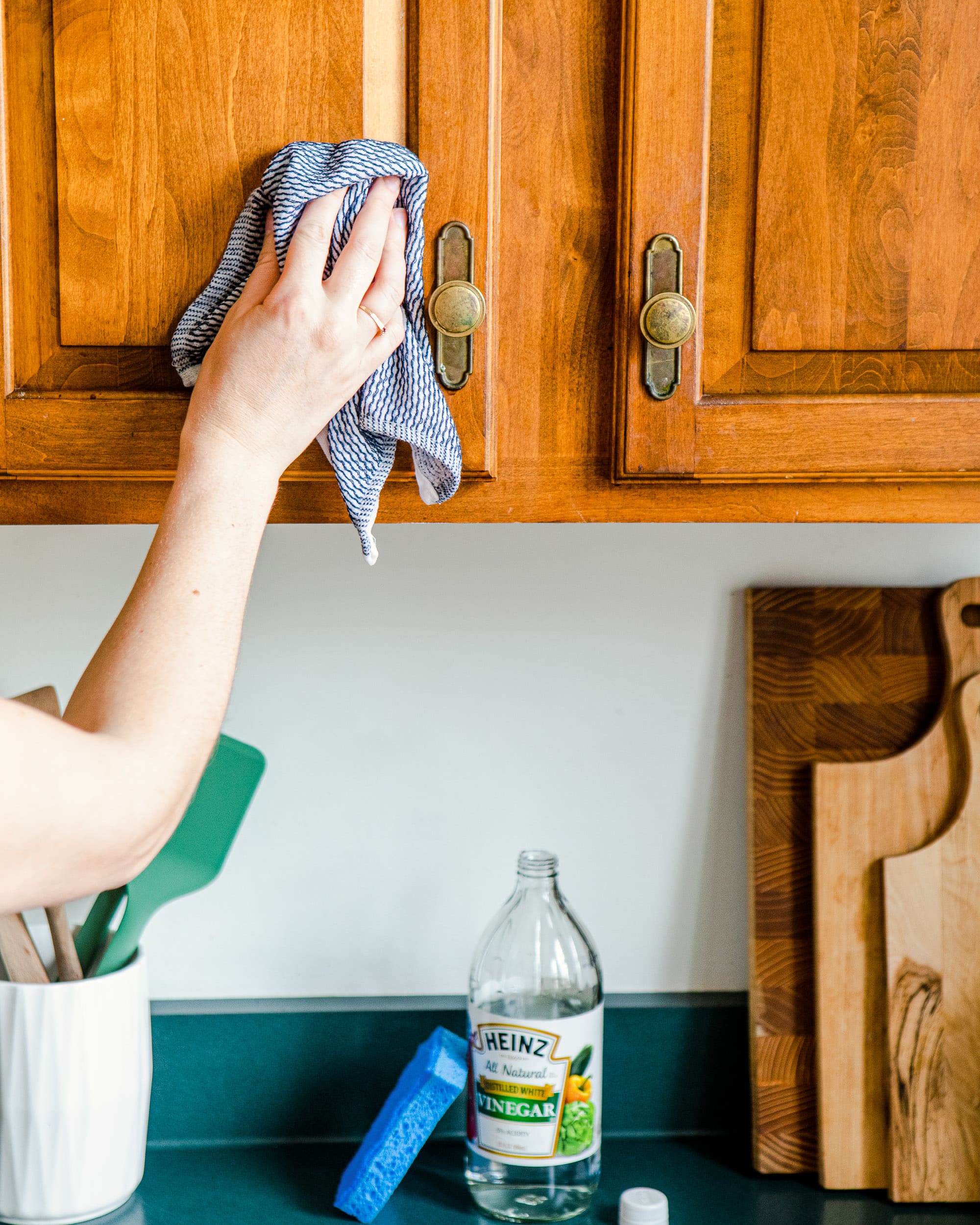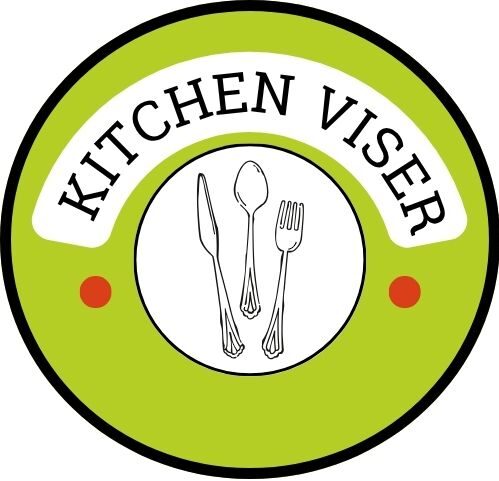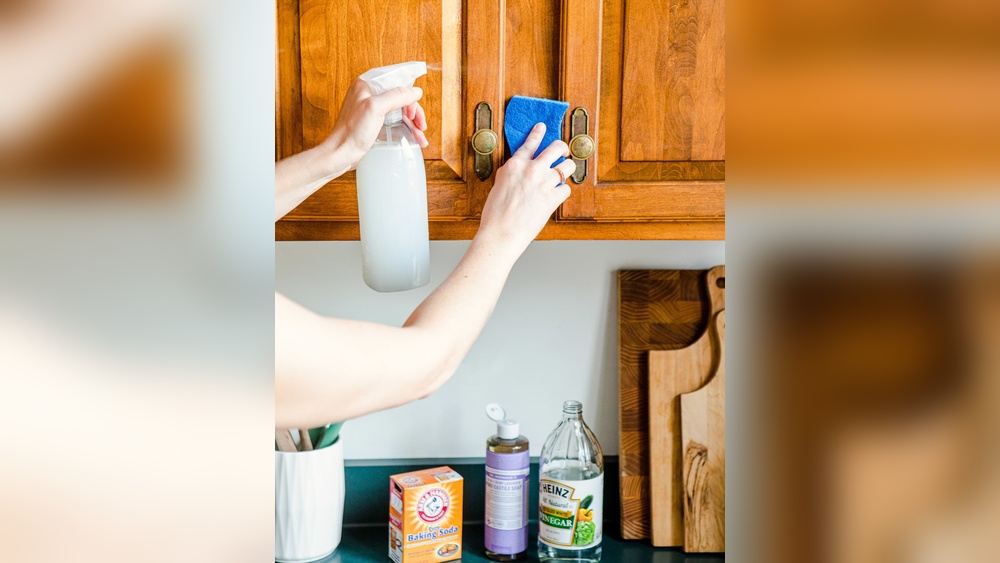Are your kitchen cabinets looking dull and sticky because of stubborn grease? You’re not alone.
Grease buildup is one of the most common problems in every busy kitchen, making your cabinets look dirty and worn out. But here’s the good news: cleaning that grease off doesn’t have to be a hassle. With the right tricks and simple ingredients you probably already have at home, you can restore your cabinets to their original shine quickly and easily.
Keep reading, and you’ll discover step-by-step methods that will make your kitchen look fresh and clean again—no harsh chemicals or scrubbing marathons needed!

Grease Removal Basics
Kitchen cabinets get greasy from cooking oils, splatters, and steam. Frying, boiling, and sautéing release tiny oil droplets that stick to cabinet surfaces. Over time, these droplets mix with dust and dirt to form a sticky layer. This buildup is common near the stove and sink areas. Grease also comes from food splashes when stirring or transferring hot items. Steam from boiling water carries oils that settle on cabinets. The warm kitchen environment makes grease soft and easier to stick. Poor ventilation worsens the problem by trapping grease in the air. Regular cooking means grease keeps layering, making it harder to clean later. Knowing where grease comes from helps in choosing the right cleaning method. Cabinets near cooking zones are usually the greasiest. Keeping these areas clean prevents thick grease layers from forming. Simple cleaning after cooking can reduce grease buildup significantly.

Simple Cleaning Solutions
Dish soap and warm water is a simple way to clean grease. Mix a few drops of dish soap with warm water. Use a soft cloth or sponge to wipe the cabinets. Clean in gentle circles to lift grease without damaging the surface. Use a soft toothbrush for corners and handles. Rinse with a damp cloth to remove soap. Dry with a clean cloth to avoid streaks.
The vinegar and dish soap combo works well for tougher grease. Mix equal parts vinegar and warm water, then add a small amount of dish soap. Apply with a cloth and scrub gently. Vinegar helps break down grease while soap cleans the surface. Rinse and dry the cabinets after cleaning.
A baking soda paste is a mild scrub for sticky spots. Mix baking soda with a little water to make paste. Apply it to greasy areas and scrub softly with a cloth or sponge. Baking soda removes grease without scratching. Wipe off with a damp cloth and dry thoroughly.
Step-by-step Cleaning Process
Start by mixing a cleaning solution. Use a few drops of dish soap in warm water. This helps break down the grease easily.
Next, wipe the cabinets gently. Use a soft cloth or sponge dipped in the solution. Wring it out well. Clean with small, circular motions to lift grease without damaging the surface.
For hard-to-reach spots, take a soft toothbrush. Dip it in the solution and scrub corners, edges, and around handles. This removes stubborn grime safely.
Finally, rinse and dry. Wipe cabinets with a clean, damp cloth to remove soap residue. Dry quickly with a dry microfiber cloth to avoid water marks or damage.
Natural Grease Removers
Mix baking soda with a little water to form a thick paste. The paste should be easy to spread but not too runny. Use about three parts baking soda to one part water for the best consistency.
Apply the paste directly on greasy spots using a soft cloth or sponge. Let it sit for 10 to 15 minutes. This allows the baking soda to break down the grease without scrubbing hard.
Wipe off the paste with a clean, damp cloth. Use gentle circular motions to remove all residue. Rinse the cloth often to avoid spreading grease back on the cabinets.
Tools That Work Best
Soft cloths and sponges are essential tools for cleaning kitchen cabinets. A microfiber cloth works well because it traps grease without scratching surfaces. Sponges with a soft side can help lift dirt gently. Avoid abrasive scrubbers that might damage the finish.
Using a soft toothbrush allows you to reach tight corners and around handles. Dip the toothbrush in a mild cleaning solution and scrub gently to remove stubborn grease. This tool is perfect for detailed cleaning without harming the cabinet.

Protecting Cabinet Surfaces
Never use abrasive cleaners on cabinet surfaces. They can scratch and damage the finish. Choose gentle, non-abrasive cleaning solutions instead. Using harsh chemicals may strip the paint or varnish.
Always clean with the grain of the wood. This helps to remove grease without harming the surface. Wiping against the grain can cause scratches and dullness.
After cleaning, dry the cabinets immediately. Use a soft cloth to prevent water spots and damage from moisture. Water left on the surface can warp or stain the wood over time.
Maintaining A Grease-free Kitchen
Keeping kitchen cabinets free from grease needs a regular wiping routine. Use a soft cloth dipped in warm water with a few drops of dish soap. Wipe the cabinet surfaces gently to avoid damage. This simple habit stops grease from building up over time.
For spot cleaning, apply a mixture of dish soap and vinegar or use a baking soda paste on tough grease spots. A soft toothbrush helps reach corners and handles. Always rinse with a damp cloth and dry to avoid streaks or water marks.
- Clean spills immediately to stop grease from hardening.
- Use kitchen vents and fans to reduce grease in the air.
- Wipe cabinets weekly with mild soap and water.
- Avoid harsh chemicals that can damage cabinet finish.
Frequently Asked Questions
What Is Best To Clean Grease Off Kitchen Cabinets?
Use a mix of dish soap and warm water with a soft cloth to clean grease off kitchen cabinets. For stubborn grease, apply a baking soda paste or dish soap with vinegar. Always wipe with a damp cloth, then dry to prevent streaks and damage.
How Do You Remove Icky Sticky Greasy Gunk From Kitchen Cabinets?
Mix dish soap with warm water. Wipe cabinets with a soft cloth in circular motions. Use a toothbrush for corners. Rinse with a damp cloth, then dry thoroughly. For stubborn grease, apply a baking soda paste, let sit, wipe off, rinse, and dry.
Avoid abrasive tools and harsh cleaners.
Can You Use Dawn To Degrease Cabinets?
Yes, Dawn effectively degreases cabinets by cutting through grease with dish soap and warm water. Use a soft cloth to gently clean surfaces. Rinse with a damp cloth and dry thoroughly to avoid damage. Dawn is safe, gentle, and ideal for removing kitchen cabinet grease.
How To Clean Wood Kitchen Cabinets Without Damaging The Finish?
Mix dish soap with warm water and use a soft cloth to wipe cabinets gently. For tough grease, apply a baking soda paste. Rinse with a damp cloth, then dry immediately to protect the finish. Always clean with the wood grain and avoid abrasive tools or harsh cleaners.
Conclusion
Cleaning kitchen cabinet grease does not have to be hard. Use gentle solutions like dish soap and warm water. For tough spots, try baking soda paste or vinegar mix. Always scrub softly with a cloth or brush to protect surfaces.
Rinse well and dry to keep cabinets shiny and safe. Regular cleaning keeps grease from building up again. Simple steps make your kitchen look fresh and neat. Keep these tips in mind for easy, effective grease removal. Your cabinets will stay clean and last longer.

Yes, working as , Food Blogger and Product Reviewer for last 6 years. Here you will get amazing deals for Smart kitchen products. I am your best source for the latest update in cooking trends. I provide insightful articles, reviews, and analysis on cutting-edge kitchen gadget. My mission is to empower readers with the knowledge they need to stay ahead in a rapidly evolving coking world. Join me as we explore the future of food technology and how it shapes our lives today and tomorrow.





